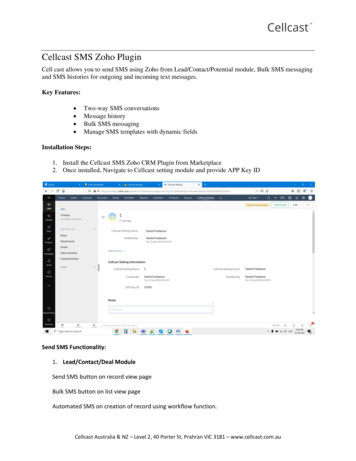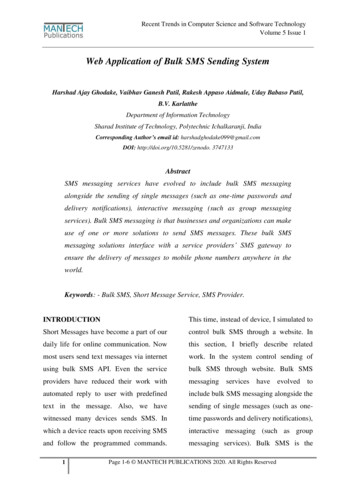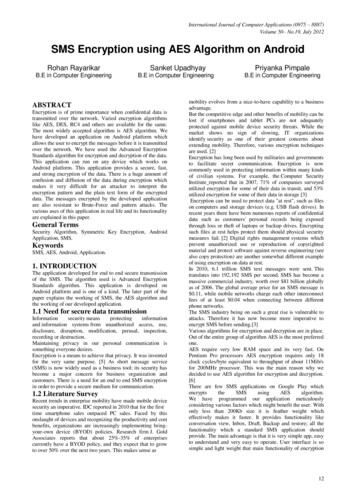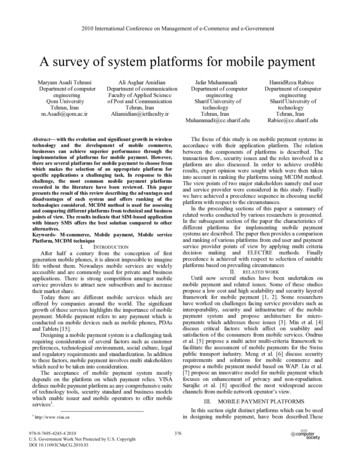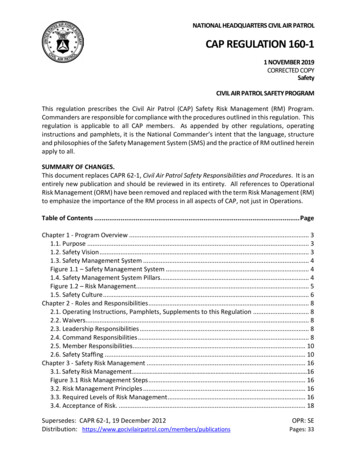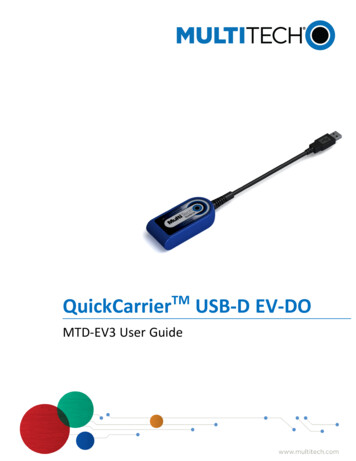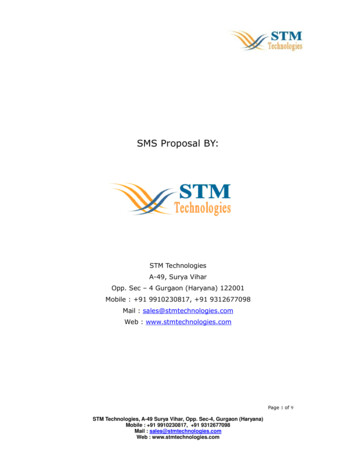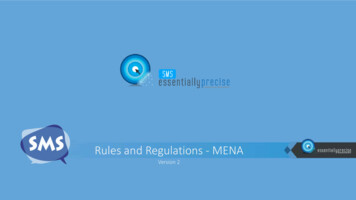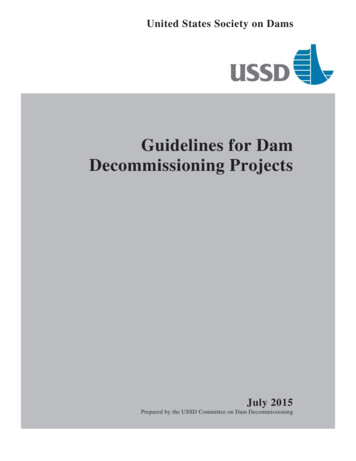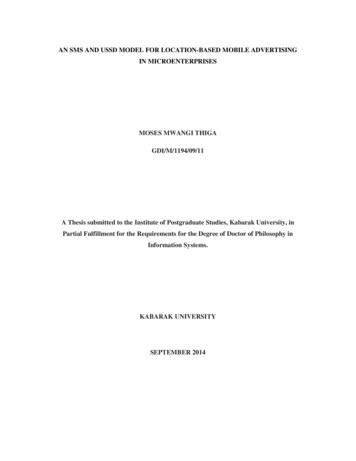
Transcription
AN SMS AND USSD MODEL FOR LOCATION-BASED MOBILE ADVERTISINGIN MICROENTERPRISESMOSES MWANGI THIGAGDI/M/1194/09/11A Thesis submitted to the Institute of Postgraduate Studies, Kabarak University, inPartial Fulfillment for the Requirements for the Degree of Doctor of Philosophy inInformation Systems.KABARAK UNIVERSITYSEPTEMBER 2014
DECLARATIONThis thesis is my original work and has not wholly or in parts been presented for the award ofa degree in any other university.Student Signature:Student Name:Admission No:Date:ii
RECOMMENDATIONTo the institute of Postgraduate studies:This thesis entitled “An SMS and USSD Model for Location-based Mobile Advertising inMicroenterprises” and written by Moses Mwangi Thiga is presented to the Institute ofPostgraduate Studies of Kabarak University. We have reviewed the thesis and recommend itbe accepted in partial fulfillment of the requirement for the degree of Doctor of Philosophy inInformation Systems.SignatureDateProf. Jason M. GithekoDepartment of Computer ScienceKabarak UniversitySignatureDateDr. Eng. Joseph K. SirorDepartment of Computer ScienceKabarak UniversitySignatureDr Kageni NjagiDepartment of EducationKabarak UniversityiiiDate
COPYRIGHTNo part of this thesis may be reproduced, stored, in any retrieval system or transmitted in anyform or by any means, electronic, mechanical, photocopying, and recording without priorwritten permission of the author or Kabarak University on that behalf. 2014 Moses Mwangi ThigaAll rights Reservediv
ACKNOWLEDGEMENTS‘The horse is made ready for the day of battle, but the victory belongs to the Lord’Proverbs 21: 31 (RSV)I praise God for the gift of life, family, friends and provision without which I wouldnot have made it this far in my academic pursuits. Indeed, the very ability to read andcomprehend is a gift that only you, God, gives. All honor, praise and glory to you.I am grateful to my wife, Mary W. Mwangi, for her great support, patience andunderstanding while I undertook this study. No one else knows how hard it really was.Many thanks to my lecturers and supervisors Dr Joseph Siror, Prof Jason Githeko, andDr Kageni Njagi for their guidance and patience throughout my studies. Your wise counsel andinput during my research have made this possible.Words are not enough to express the gratitude for you my parents, Stanley and Rachael.You have supported, motivated, encouraged and disciplined me throughout my life andacademic journey. What would I be without you?A million thanks and God’s blessings to my siblings, Sospeter, Shiku, Nelly, Mureithi,John and Vicky, my aunt, Rose for being my prayer partners.I also acknowledge my research assistant Jane W. Mutiga for her tireless efforts duringmy fieldwork.v
DEDICATIONToMy Dad, Dr. S.T. MwangiMy Mum, Mrs. Rachel M. ThigaMy Wife, Mary W. MwangiMy little angel, Rachel Njoki Mwangivi
ABSTRACTTechnological and financial limitations have hampered the effective advertisement of productsand services by microenterprises thus limiting their contribution towards national economicgrowth. Recent advances in mobile technologies makes the use of location based mobileadvertising (LBMA) a viable option in addressing this challenge. However, a majority ofLBMA are developed for use on smart and feature phones with inbuilt positioning and programexecution capabilities thus leaving out a majority of microenterprises who use basic phones.This study therefore examined the use of alternative positioning methods, namely symbolicand network based geo-location, and device independent system access methods; SMS andUSSD, for the development of LBMA for use by microenterprises. Functional decompositionand rapid prototyping methodologies were utilized to develop a suitable LBMA applicationmodel and system prototype respectively. The prototype utilizing network based geo-locationproved to be successful in delivering LBMA services to microenterprises. The delivery ofLBMA services to microenterprises using network based geo-location, SMS and USSD wastherefore found to be feasible and practical. It is therefore recommended that this approach bescaled up and commercialized whilst addressing emergent adoption issues such as cost andsecurity concerns occasioned by the use of user’s real time locations.Keywords: SMS, USSD, Location-based mobile advertising, microenterprisesvii
TABLE OF CONTENTSDECLARATION. iiRECOMMENDATION . iiiCOPYRIGHT . ivACKNOWLEDGEMENTS . vDEDICATION . viABSTRACT . viiLIST OF TABLES . xviiLIST OF FIGURES . xviiiCODE LISTINGS . xxiABBREVIATIONS . xxiiOPERATIONAL DEFINITION OF TERMS. xxiiiCHAPTER ONE . 1INTRODUCTION . 11.0 Introduction . 11.1 Background . 11.2 The problem . 31.3 Objectives of the study . 31.4 Research questions . 41.5 Justification of the study . 41.6 Significance of the study. 5viii
1.7 Scope of the study . 61.8 Assumptions . 71.9 Expected outcomes . 71.10 Conclusion . 8CHAPTER TWO . 9LITERATURE REVIEW . 92.0 Introduction . 92.1 Microenterprises and marketing . 92.2 Location-based Services . 102.3 Location determination . 142.4 Mobile advertising . 182.5 Location-based mobile advertising . 192.6 Short Messaging Services (SMS) . 342.7 Unstructured Supplementary Service Data (USSD). 392.8 Theories informing the study . 422.8.1 Information systems research . 422.8.2 Systematic innovation . 432.8.3 Technology Acceptance Model (TAM) . 472.8.4 Diffusion of innovations . 512.9 Conceptual framework. 532.10 Conclusion . 56ix
CHAPTER THREE . 57METHODOLOGY. 573.0 Introduction . 573.1 Research authorization. 573.2 Systematic innovation process . 573.3 Customer needs analysis survey . 593.3.1 Objectives of the survey . 593.3.2 Research questions. 593.3.3 Research hypothesis . 593.3.4 Research model. 603.3.5 Measurement methodology . 603.3.6 Population. 613.3.7 Sample size calculation . 613.3.8 Sampling procedure . 623.3.9 Instruments . 633.3.10 Pilot study. 653.3.11 Reliability . 663.3.12 Data analysis. 663.4 Model development . 673.5 Prototype development . 673.6 Prototype evaluation . 69x
3.7 Conclusion . 70CHAPTER FOUR . 71RESULTS AND DISCUSSION . 714.0 Introduction . 714.1 Factors influencing the intention to use location-based mobile advertising amongmicroenterprises . 714.1.1 Introduction . 714.1.2 Study findings . 724.1.3 Discussion . 824.1.4 Enhanced Technology Acceptance Model (E-TAM) . 844.1.5 Conclusion. 854.2 An SMS and USSD model for location-based mobile advertising . 854.2.1 Introduction . 854.2.2 System Objectives . 854.2.3 System functionality . 864.2.4 System components . 874.2.5 Interfaces between system components . 904.2.6 Processes required to achieve system functionality. 904.2.7 Conclusion. 934.3 Design and testing of the location-based SMS and USSD mobile advertising system934.3.1 Introduction . 93xi
4.3.2 System overview. 934.3.3 User and provider registration process . 944.3.4 Information search process. 944.3.5 Advertisement placement process . 944.3.6 Advertisement delivery process. 944.3.7 Entity relationship diagram . 954.3.8 Proof of concept. 1034.3.9 Performance evaluation. 1124.3.10 Conclusion. 1134.4 Pilot study of the location-based SMS and USSD pull mobile advertising system . 1134.4.1 Introduction . 1134.4.2 Sample selection . 1144.4.3 Piloting procedure . 1144.4.4 Pilot study report. 1154.4.5 Conclusion. 1204.5 Limitations and challenges in implementing location-based mobile advertising servicesusing SMS and USSD. 1214.5.1 Introduction . 1214.5.2 Limitations of the SMS and USSD mobile advertising system . 1214.5.3 Challenges facing the SMS and USSD location-based mobile advertisingsystem. 123xii
4.5.4 Goal based evaluation . 1234.5.5 Conclusion. 1264.6 Using network-based geo-location to deliver SMS and USSD location-based mobileadvertising . 1264.6.1 Introduction . 1264.6.2 The Network-based Geo-location SMS and USSD Location-based MobileAdvertising Model . 1264.6.3 Proof of concept. 1304.6.4 Performance evaluation. 1384.6.5 Applications areas for the network based geo-location LBMA . 1394.6.6 Conclusion. 1394.7 Potential spinoff applications of the location-based mobile advertising system . 1394.7.1 Introduction . 1394.7.2 Mobile contracts . 1404.7.3 Identity verification process . 1414.7.4 Targeted advertising . 1424.7.5 Demand and supply statistics . 1424.7.6 Conclusion. 144CHAPTER FIVE . 145CONCLUSIONS AND RECOMMENDATIONS . 1455.0 Introduction . 145xiii
5.1 Conclusions . 1455.1.1 Research Question 1: What is the level of awareness, utilization and potential forLBMA among microenterprises? . 1465.1.2 Research Question 2: What is the most suitable application model for thedevelopment of SMS and USSD location-based mobile advertising services? 1475.1.3 Research question 3: What are the challenges of implementing the SMS and USSDLBMA prototype? . 1485.1.4 Research Question 4: How does the SMS and USSD location-based mobileadvertising prototype perform? . 1495.1.5 Research Question 5: What are the additional areas of application of the SMS andUSSD LBMA prototype? . 1495.2 Areas for further study . 1505.2.1 The commercialization of the LBMA . 1505.2.2 The role of risk, convenience and perceived benefits in influencing user intentionto use LBMA . 1515.2.3 The impact of system demonstration versus system descriptions in influencingperceived ease of use . 1515.2.4 Choice of technology, perceived ease of use and user socio-demographiccharacteristics in the adoption of LBMA . 1525.2.5 A security model for the delivery of LBMA using SMS and USSD. 1525.2.6 Towards an effective delivery of LBMA using SMS . 1525.2.7 Investigating the user trust development process for LBMA . 153xiv
5.2.8 A business model for the sustainable delivery of SMS and USSD LBMA amongmicroenterprises. 1535.2.9 An intelligent and efficient USSD menu management system for the delivery ofLBMA . 1535.2.10 A model for the secure utilization of user real-time location in the delivery ofLBMA . 1545.2.11 Using an SMS and USSD identity confirmation model to address securitychallenges among microenterprise public transport operators . 1545.2.12 Using an SMS and USSD identity confirmation model for passenger identificationand manifest in public service transport . 1545.2.13 Using SMS and USSD for mobile contracts . 1555.2.14 Demand and supply mapping using SMS and USSD LBMA . 1555.3 Recommendations . 1555.3.1 National integrated identity management system . 1555.3.2 Development of a mechanism for safe and acceptable access and use of user’s realtime location information . 156APPENDIX A . 168MICROENTERPRISES QUESTIONNAIRE . 168APPENDIX B . 171OBJECTIVE ONE RESULTS . 171APPENDIX C . 180SYSTEM CORE SOURCE CODE . 180xv
APPENDIX D . 202PILOT STUDY MATERIALS . 202APPENDIX E . 207AUTHOR PROFILE. 207LIST OF PUBLICATIONS . 207APPENDIX F . 208RESEARCH PERMIT . 208LETTER OF INTRODUCTION . 209xvi
LIST OF TABLESTable 1: Summary of LBMA applications reviewed . 30Table 2: Microenterprises sampled . 63Table 3: Demographics . 72Table 4: Level of awareness of location-based mobile advertising among microenterprises . 73Table 5: Factor Analysis Variables . 74Table 6: Initial extracted Eigen values . 76Table 7: Final extracted Eigen values . 77Table 8: Final rotated factor solution . 79Table 9: Descriptive statistics for the intention to use location-based mobile advertising scale(n 304). 80Table 10: Tests for normality . 80Table 11: Factor score correlations . 81Table 12: User views on LBMA prototype . 115Table 13: Inter-item correlations . 171Table 14: Initial KMO and Bartlett's test . 173Table 15: Initial anti-image matrices . 173Table 16: Initial communalities . 175Table 17: Initial factor loadings based on a principal components analysis for 17 items of theintention to use location-based mobile advertising scale (n 304) . 176Table 18: Final KMO and Bartlett's Test . 177Table 19: Final anti-image Matrices . 177Table 20: Final Communalities . 179Table 21: Correlations between risk, convenience and perceived benefits. 179xvii
LIST OF FIGURESFigure 1: Basic components of an LBS and information flow by Steiniger et al. (2006). 12Figure 2: LBS application categories by Steiniger et al. (2006). 13Figure 3: Angle of Arrival by Clarkson, McCallum, Solhjoo, & Velentzas (2004) . 16Figure 4: Time of Arrival by Clarkson, McCallum, Solhjoo, & Velentzas (2004) . 17Figure 5: Placecast mobile advertising platform by Placecast (2013) . 21Figure 6: System architecture for the location-based mobile application by Sammut et al(2010). . 23Figure 7: B-MAD Bluetooth-based geo-location and mobile advertisement delivery systemby Aalto et al. (2004). 25Figure 8: GPS and SMS vendor tracking system by Dawood et al. (2010) . 26Figure 9: Architecture of SMMART framework by Kurkovsky & Harihar (2006) . 27Figure 10: SMS-Enabled GSM network architecture by Bodic (2003) . 37Figure 11: SMS system architecture by J. Brown, Shipman, & Vetter (2007) . 38Figure 12: USSD in GSM by Sanganagouda (2011) . 41Figure 13: Essential elements of a successful innovation by Mann (2004) . 44Figure 14: Systematic innovation process by Sheu & Lee (2011) . 46Figure 15: Technology Acceptance Model by Davis et al (1989) . 47Figure 16: Five stages in the decision innovation process by Rogers (1995) . 52Figure 17: Conceptual framework for the USSD and SMS location-based mobile advertisingapplication . 55Figure 18: Location-based mobile advertisement delivery process . 56Figure 19: Systematic innovation process for the development of an SMS and USSDlocation-based pull mobile advertising application . 58Figure 20: Model for intention to use location-based mobile applications . 60xviii
Figure 21: Functional decomposition process by NASA (2004). 68Figure 22: Rapid prototyping by NASA (2004) . 69Figure 23: Enhanced Technology Acceptance Model (E-TAM) . 84Figure 24: USSD and SMS location-based mobile advertising application architecture . 92Figure 25: Flow chart of the LBMA system use .
AN SMS AND USSD MODEL FOR LOCATION-BASED MOBILE ADVERTISING IN MICROENTERPRISES MOSES MWANGI THIGA GDI/M/1194/09/11 A Thesis submitted to the Institute of Postgraduate Studies, Kabarak University, in Partial Fulfillment for the Requirements for the Degree of Doctor of Philosophy in
